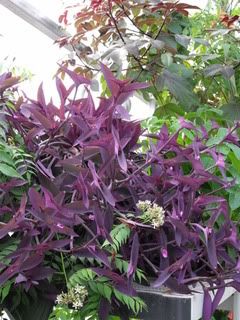Purple Heart

Tradescantia pallida is a very eye catching type of Wandering Jew. It is commonly called “Purple Heart” and has very striking purple foliage. The plant is a trailer; it does very well in hanging baskets. It is also extremely easy to propagate, making it a favorite of many houseplant hobbyists.
 Purple Heart prefers bright sun and will do well in full sun to partial shade. The more sun you can provide the better. The leaves tend to get a bit on the green side when the plant is receiving lower light quantities and the purple foliage is kind of the best feature of the plant. It also has small pink tri-petaled flowers which will appear in greater abundance in higher light.
Purple Heart prefers bright sun and will do well in full sun to partial shade. The more sun you can provide the better. The leaves tend to get a bit on the green side when the plant is receiving lower light quantities and the purple foliage is kind of the best feature of the plant. It also has small pink tri-petaled flowers which will appear in greater abundance in higher light.
This plant is considered to be drought-tolerant when used in the landscape. Keep that in mind when growing it indoors. It prefers to stay on the dry side. Plant your Purple Heart in a pot or hanging basket that isn’t too big so that the plant can easily dry out over the course of a week. The potting mix should never be allowed to dry out completely but should be pretty dry about an inch down. If the plant is grown in a shadier location, remember that it will dry out more slowly. Fertilize at every other watering with a general purpose fertilizer.
There are several insects that like Purple Heart, including spider mites, mealy bugs, and aphids. If you check the plant out closely before exposing to your other plants, you should be pretty safe. I usually leave new additions out in the hallway for a week before mixing them in with the rest of the collection.
Propagate your Purple Heart by taking cuttings and rooting them in moist potting mix. I have gotten the best results when covering the pot with plastic wrap and sealing it with a rubber band. Once new growth is observed, the rubber bands come off and the new plant is slowly acclimated to the lower humidity of the outside atmosphere. Rooting hormone isn’t necessary.
Purple Heart gets very stringy and needs to be repotted regularly. One solution is to propagate a new plant once a year, usually in the spring, with the cuttings you take from your old plant. Whether you chose to propagate a new plant is up to you, but the old plant will need trimming and repotting anyway. Pruning will help keep the plant healthy and encourage branching, so don’t be shy about it. Your final result will be a lush and happy Purple Heart.

This plant is considered to be drought-tolerant when used in the landscape. Keep that in mind when growing it indoors. It prefers to stay on the dry side. Plant your Purple Heart in a pot or hanging basket that isn’t too big so that the plant can easily dry out over the course of a week. The potting mix should never be allowed to dry out completely but should be pretty dry about an inch down. If the plant is grown in a shadier location, remember that it will dry out more slowly. Fertilize at every other watering with a general purpose fertilizer.
There are several insects that like Purple Heart, including spider mites, mealy bugs, and aphids. If you check the plant out closely before exposing to your other plants, you should be pretty safe. I usually leave new additions out in the hallway for a week before mixing them in with the rest of the collection.
Propagate your Purple Heart by taking cuttings and rooting them in moist potting mix. I have gotten the best results when covering the pot with plastic wrap and sealing it with a rubber band. Once new growth is observed, the rubber bands come off and the new plant is slowly acclimated to the lower humidity of the outside atmosphere. Rooting hormone isn’t necessary.
Purple Heart gets very stringy and needs to be repotted regularly. One solution is to propagate a new plant once a year, usually in the spring, with the cuttings you take from your old plant. Whether you chose to propagate a new plant is up to you, but the old plant will need trimming and repotting anyway. Pruning will help keep the plant healthy and encourage branching, so don’t be shy about it. Your final result will be a lush and happy Purple Heart.
This site needs an editor - click to learn more!
You Should Also Read:
Spider Mites
Non-Toxic Pest Control
Houseplants Newsletter
Related Articles
Editor's Picks Articles
Top Ten Articles
Previous Features
Site Map
Content copyright © 2023 by Lisa Beth Voldeck. All rights reserved.
This content was written by Lisa Beth Voldeck. If you wish to use this content in any manner, you need written permission. Contact
BellaOnline Administration
for details.


